
Writing Product Descriptions that Engage and Convert
This guest blog was written by a representative from CrowdContent.

The “post it and they shall buy” mindset doesn’t always work in today’s online retail landscape. Sellers need to do more to engage browsers and turn them into buyers. High-quality photos for your products are a given, but well-written product descriptions are equally important.
As a leading content writing service, Crowd Content has written over 100,000 product descriptions for large, medium and small retailers. We’ve learned quite a bit along the way on producing descriptions that engage readers and ultimately result in sales.
Bigger Isn’t Always Better
The types of products you sell should be the ultimate driver in how long your product descriptions are. Simple products like phone cases and hair clips might only need 50 words to get the point across, but feature-rich products like electronics and appliances might need descriptions that are 150 words or more.
Hamilton Beach has a product description for this digital toaster oven that’s over 350 words.
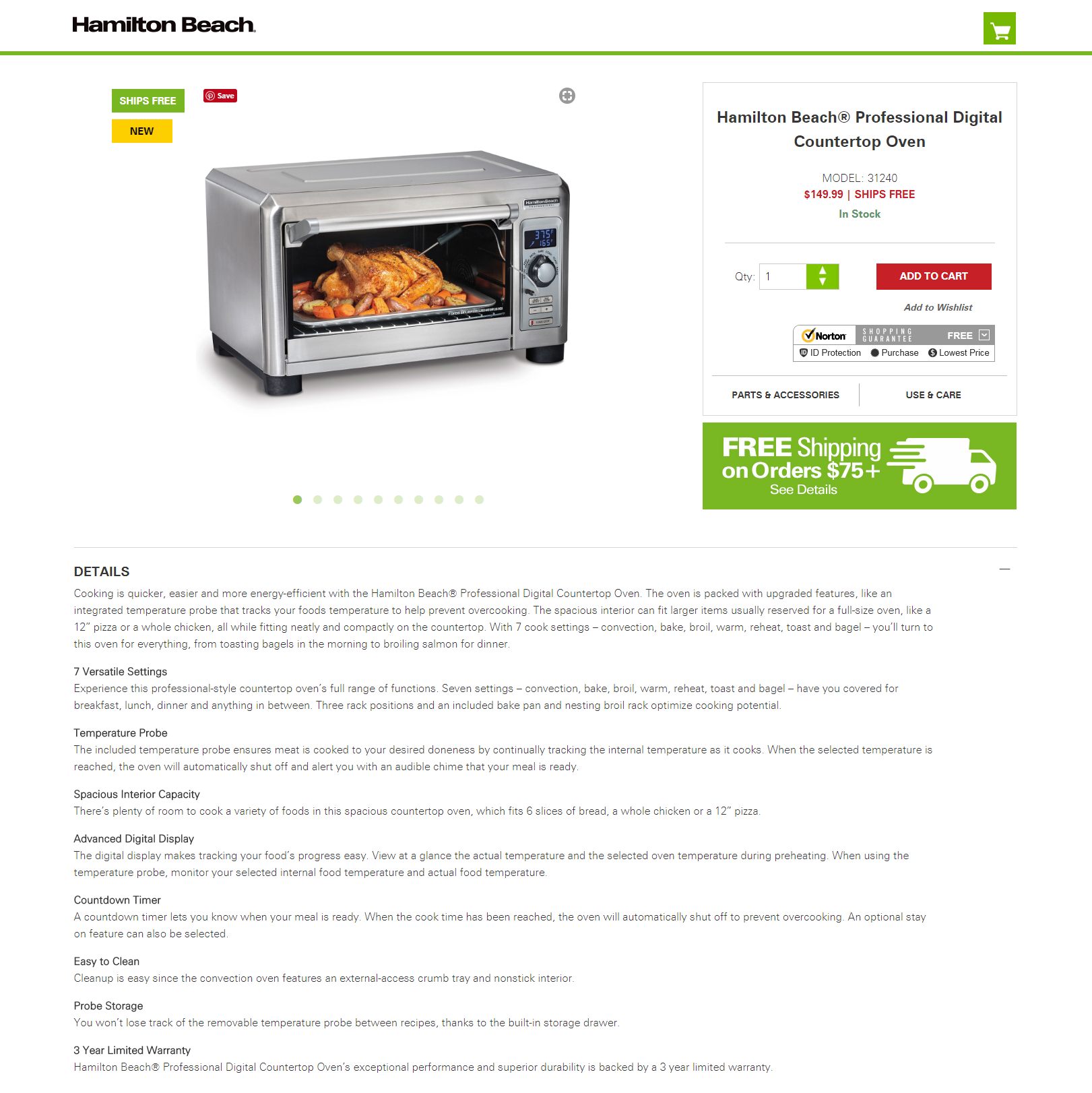
But SaharaCase needed a mere 86 words to talk about this phone case.
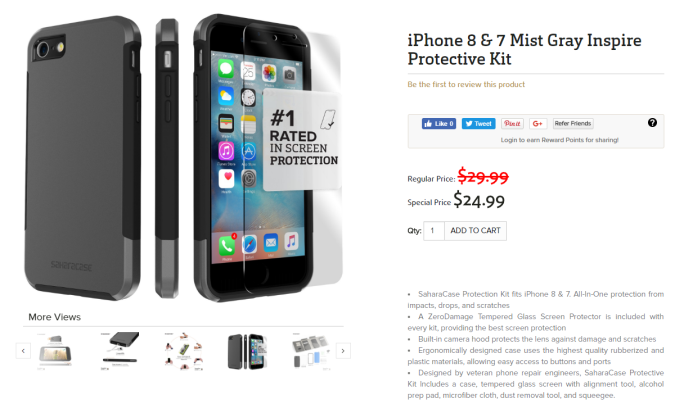
A Voice to Match the Brand
Before you start to write your description, pin down a voice that matches your brand and will resonate with your consumers. For example, if you’re selling party goods, a lighthearted, humorous tone in your product descriptions is the way to go. However, that won’t work if you’re selling law books or medical equipment.
The product description for this simple bottle of hand wash from Method almost compels you to buy it.
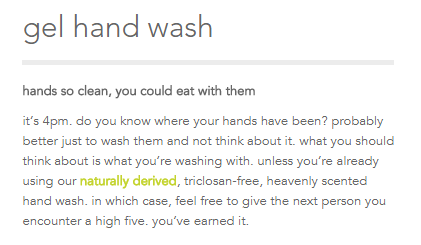
Office Depot uses a much more professional tone when selling office furniture.
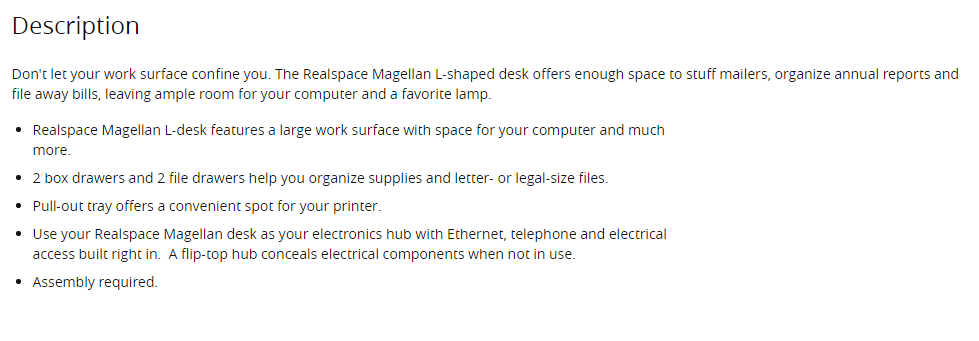
ThinkGeek applies an appropriately humorous tone to sell animal paw-shaped slippers.

There’s More Than One Style of Writing?
Yes. And you must figure out which is the best style for your brand. One of the most popular styles of writing product descriptions is a simple feature-benefit structure. Product descriptions using feature-benefit pairing highlight the primary selling features of a product and explain how the consumer can benefit from it.
This short but sweet description for an ASUS laptop masters the art of feature-benefit pairing.

Though feature-benefit writing is very popular, some products do better with a storytelling approach.
Just about everyone can connect with this product description for a grilling multi-tool.

Luxury products often do well using an aspirational style of writing, where the goal is to make an emotional connection with the consumer. It creates a fit between the product and the consumers’ emotions and attitudes, making it easy for them to positively identify with the product.
PERVERSE sunglasses has nailed the art of aspiration in this description for a simple pair of black-framed sunglasses.
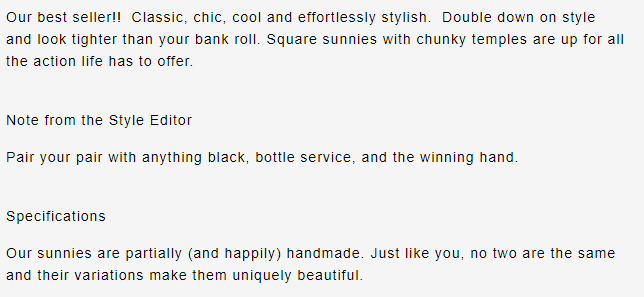
Keep Things Scannable
Many consumers want to quickly cut to the chase, and bulleted lists of the product’s key features are important for them. Some manufacturers prefer exhaustive lists of all a product’s features, but you can keep things simple by listing those that meet any of these criteria:
-
The Information is crucial to the consumer’s decision process. There’s some information the customer can’t live without, and by putting it front and center in a bulleted list, you’re making it easy for them to find it. Think how difficult it would be to sell a shirt without divulging the size or a pack of copy paper without letting the reader know how many sheets are in it.
- It’s a feature that sets the product apart from the competition. Put your key selling features out there on display to let the reader know why they should buy your product. You don’t need to tell the reader that the oven you’re selling cooks food, but you do need to tell them that it doubles as a convection oven.
Staples opted for an exhaustive list in this laptop product description.
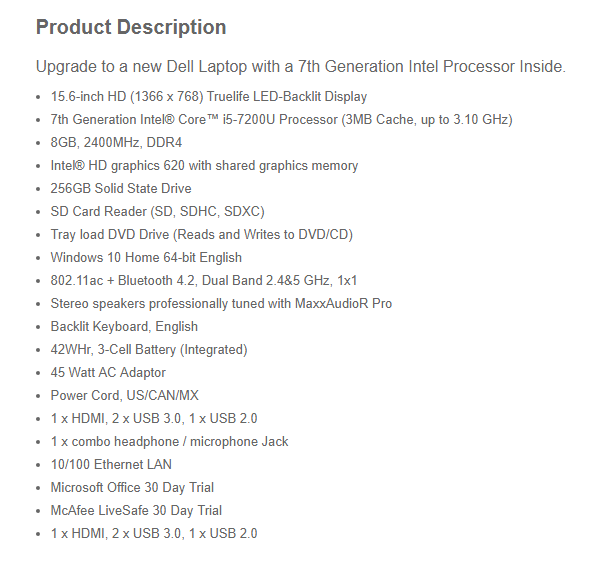
Need Help?

If the task of writing product descriptions that engage and convert seems daunting, take advantage of our army of writers and professional editors to help. We’ve got the experience you need to take your Bonanza shop to new levels. Contact us today to get started. Plus, as a Bonanza seller, you can get a 15% bonus when you fund your Crowd Content account for the first time. Just use the promo code Bonanza15 when asked.
This guest blog was written by a representative from CrowdContent.<< Back
Recent Posts

Recent Outtage
Oct 29, 2025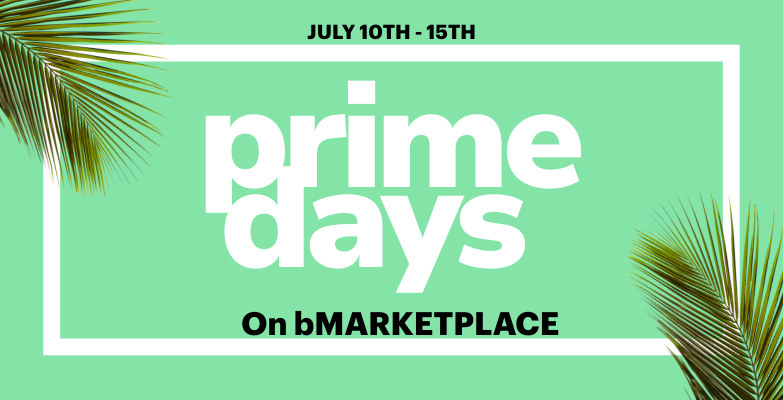
Prime Days...on bMarkeptlace!
Jul 9, 2025
Father's Day promo
Jun 3, 2025
An Important Announcement from Our Team
May 13, 2025
Cleaning House: How We're Cracking Down on Fraud to Protect the Bonanza Community
Mar 26, 2025

20 response to Writing Product Descriptions that Engage and Convert
The “descriptions that engage and convert” depend entirely on what kind of items you’re selling.
If you are selling technical type items, then you don’t add in a bunch of fluff. If you’re selling clothing or jewelry, you need to be precise about sized. “Fits most” doesn’t do it. You have to measure. If it’s a garment that can’t be machine-washed, say so.
If on the other hand, you are selling things like collectibles or vintage items, people like to know more about their origins. Sometimes, Where did you get it? Passed down in your family? On a trip to Ireland? I once got top dollar for selling a cribbage board that dated back to the 1930’s because I was able to say that it was my dad’s and had been knocked around while he was on a minesweeper in the South Pacific.
If you know how something was made, that’s useful information. Example: vintage beads. They aren’t signed. In many instances, they were cottage industries – a family made the beads, and – then sold them, so there weren’t a lot of any one variety. There is a built-in rarity factor.
Selling dolls? Who made it? What for? How many? (That’s not always important, but that varies.) Size? Type? Collector dolls? Fashion dolls? Child dolls? Suitable for very young children (no parts that the child can bite off and swallow? Can it be cleaned?)
If your item is being sold in a lot – example beads, or screws, or envelopes – whatever – way up front – right in your title – give the total number of items. Don’t make somebody search for that, because chances are, they won’t. They’ll see your price and think, “That’s an awful lot of money for one of those,” not realizing there are 20 in the lot.
You have to spend a lot of time researching what you sell before writing your descriptions – unless, as I commented earlier, if they are stock items and the manufacturer has already done a very good job of describing them.
Sometimes, I look at listings and wonder if the seller thinks they get charged by the word: description is so minimal it tells me nothing.
I know lots of people don’t read it all, but it’s there for them.
If you’re selling books: talk about the books. A novel – give an outline of the plot – under no circumstances, give away the ending if it’s a mystery or horror novel! History – give a bit of information about country, time period, and the effect on the times. Cookbook – tell what kind of recipes are in it. If the author him or herself is especially interesting, or writes under a pseudonym, mention it.
Those are just the things that I personally consider. Some of it may be helpful to you; some of it won’t.
Carolyn
Carolyn!! You are a champion for sharing this helpful information. Thank you for helping the Bonanza selling community learn and improve. We appreciate you!!
BonanzaGrace
Thanks, Grace. Back in the day, when I was a journalist, I learned something that can be very good advice. Take pictures as if there were no description; write description as if there were no pictures – and use both!
Descriptions I find, for me, are the hardest. One tip I’ve learned is that even if I write up a listing today and it sounds great at the time, it’s always important to go back and read it at least one more time. Because what our “ears” do not hear the day we write it, we’re sort of stepping out of our box when we read it again on a brand new day.
Sometimes I’ve looked back and thought to myself what in the world was I thinking when I wrote that description up.
There are times when a certain category just does not fit with my writing style either or there are products I run across where I know I am going to have a real hard time describing the item. So, I avoid these now but that’s just me. Now if it is something that will go for a nice decent price, I buy it, grin and bear it when listing and hope for the best.
Another thing I will do to try and help me enhance descriptions is to use Google. For example, I have a bottle of men’s cologne with a fragrance titled as Excalibur. The bottle was also designed with a sword on the front of it. I felt I could add some interest to the description. So I searched Google for swords, looking at different types of articles on it.
And so after researching it, I came up with this punchline:
This cologne decanter reminds me of the King Arthur era when unusual swords were used and rock walkways lead up to castles.
(These are my own words I might add. Never copy anything off of the internet. Be yourself)
Thanks so much for sharing your helpful tips and wisdom, EmpressDepot!!
Helpful
Very useful information.
Thank you so much for your helpful and useful information.
What a great and very useful article!
I,m Alway’s Brain storming but for some reason i get ton’s of watchers but no sales this is really a struggle for me and yes i read write and rewrite a lot on my items it seems like i,m writing in a different Language.never knew selling could be so hard.
Thanks. I really need all the help I can get. I do research but always wonder “now what do I say to describe it”.
Thank you for the help!
Buyers on mobile usually only read the title, so I put as much pertinent info in it. Nobody searches for cute, beautiful, etc. They want brand, if it is relevant, color, size, material. I include the same info in the description with additional features that cannot fit in the title. And measurements.
Thank you!
Thanks for these tips- now if you could just give buyers some tips to read the description!!
Thank you for the information that is already an admin give salam success to bonanza is very helpful
to grita_stuf2—don’t you agree that, for instance, you are selling bracelets and you give the title “I Shot the Sheriff”, it would pique someone’s interest enough for them to at least give the bracelet a look? I may be totally wrong but I think I would at least look.
I don’t know about that, sandikaye, but I do recall titling one listing – The Ugliest Beads I Have Ever Seen – and they sold quite quickly.
I’ve sold doll clothes with titles that started, “Whatzit,” but also stated what the item was, and they’ve sold, too.
If I were selling an odd-ball thing like a cherry-pitter, , I might try cutesy, but I’d also state that the “whatever-it is” is a food preparation implement…..but that’s just me.
Somehow, I’m inclined to think it’s a really good idea to say something about the object itself in the title.
If someone’s got a cute cat sweater to list, they could put “purrtiest” pink sweater (lol I’m kidding, sort of). Sometimes I do like to have fun with a listing. I’ve got a few descriptions where a rhyme just happened to pop out and so I just leave the rhyme in there. This typically only happens when it is something cute/fun to list.
great article, very informative. I think more precise descriptions works better and I like the idea of voice to match brand
Login to see more comments